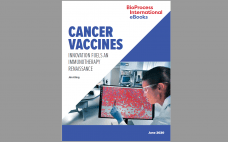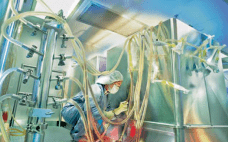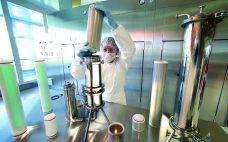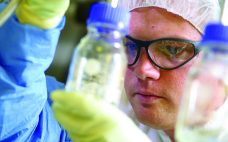Countless factors influence a bioprocess, and measuring and evaluating them can be a major challenge. One of the most important performance parameters is the volumetric mass-transfer coefficient (kLa). ZETA has developed a reliable method for determining the kLa value and thus has revolutionized bioreactor design in plant engineering. With ZETA’s mass-transfer coefficient value determination system, measurements to determine kLa value can be taken at any point in a bioreactor, and based on such measurements, production conditions can be mapped perfectly.…
2020
eBook: Expression Systems — Innovative Techniques for Conventional Cell Lines
Although Chinese hamster ovary (CHO) and Escherichia coli cells have become the biopharmaceutical industry’s preferred platforms for producing recombinant proteins, perennial challenges have limited the capabilities of those expression systems. New CHO lines and improved upstream methods steadily are increasing expression titers, yet researchers continue to decry CHO’s relatively low growth rate. E. coli exhibits strong growth kinetics but cannot perform posttranslational modifications necessary for complex therapeutic proteins. Researchers need advanced technologies and analytical methods to overcome such limitations. This…
Early Stage Analytical Considerations for Late Stage Biologics Success
This BPI Special Report will cover phase appropriate analytical strategies that will balance various drivers to meet overall development goals without sacrificing the requirements of a program. The goal is to provide important recommendations for analytical method development that can help the biopharmaceutical industry identify opportunities to improve lead time and reduce development costs while maintaining required quality standards. Fill out the form below to learn more about analytical method development now. Arugadoss Devakumar, PhD, is director of analytical…
eBook: Cancer Vaccines — Innovation Fuels an Immunotherapy Renaissance
Despite early successes a decade ago, cancer vaccines designed to deliver peptides or proteins — or nucleic acids encoding those antigens — generally have fizzled out since then. As a result, cancer vaccine development and the field of immunotherapy lost some traction overall. But as freelance contributor Jim Kling describes in this eBook, new innovations in product design, testing, and manufacturing are fueling a renaissance in cancer vaccine development. From checkpoint inhibitors to neoantigens, immune regulators, and beyond, companies are…
eBook: Formulation, Fill, Finish — Biopharmaceutical Drug Products for a Modern Age
Biopharmaceutical drugs are increasing in sophistication, requiring technological advancements to solve related challenges. The contributors to this BPI eBook highlight drug-product formulation concerns and collaborative efforts toward solving the fill–finish conundrum. First, the BioPhorum’s Scott Ewan describes a holistic approach to container–closure integrity and the organization’s work toward developing and expanding upon that approach. Ewan explores how advancing analytical technologies, risk management, and quality by design (QbD) are changing the strategies related to container–closure integrity, which remains a significant aspect…
Application of Targeted Locus Amplification for Enhanced Apollo X CHO Clone Screening
Speed to market is an important consideration for the development of lifesaving therapies, including recombinant monoclonal antibodies. However, increased speed must be balanced with quality to enable quick and efficient delivery of biopharmaceuticals to patients. Important determinants of quality include the genomic location and integrity of the transgene sequence within a recombinant cell line. Traditional methods of genetic characterization can provide incomplete information and results can be difficult to interpret. However, next-generation sequencing (NGS) approaches such as Targeted Locus Amplification…
Finding Efficiencies to Accelerate Biopharmaceutical Development
An old engineering adage says that in any technical project, you can get speed and/or quality and/or cost-efficiency — but you never get to have all three. The idea is that emphasizing any one of those parameters necessarily deemphasizes one or both of the others. For most of the biopharmaceutical industry’s early years, companies operated on that assumption. Many organizations saw speed as the weakest link that could be more or less ignored; others had money to burn. The smartest…
The Upstream Perspective: Taking Efficiency Beyond Cell-Line Development
With 20 years of experience in the biopharmaceutical industry — at Genentech, Applied Biosystems, Cell Genesys, Cellerant Therapeutics, and Bayer — Yuval Shimoni has written frequently for BioProcess International on a number of production topics. Those have ranged from process improvements and bioreactor scale-down validation, to raw materials management, to addressing variability and virus contamination events. For this featured report, we discussed hardware and instrumentation, quality by design (QbD) and related approaches, and other strategies that can take expediting upstream…
The Downstream Perspective: Putting Product Knowledge to Work Using Technological Innovations
After over a quarter century in the industry — including downstream processing (DSP) and manufacturing directorships at Boehringer Ingelheim and leadership roles in technology development, quality, and manufacturing at Novasep — European consultant Margit Holzer is a recognized expert in downstream processing of biopharmaceutical products. Holding a doctorate in biotechnology from the University of Natural Resources and Applied Life Sciences in Austria, Holzer is familiar to BPI readers as both an author and conference participant (1, 2). And in May…
The Analytical Perspective: Turning Data Into Information Requires Teamwork
As head of bioanalytics at Sanofi, Claire Davies leads a team of >90 people involved in development, qualification, and transfer of methods to internal and external commercial quality control units; characterization, comparability, and developability of proteins and gene therapies; and analytical support for up- and downstream development, production, product release, and stability testing. She has served in a number of roles over 18 years with Sanofi, from chemistry, manufacturing, and controls (CMC) leadership of preclinical to commercial products (leading and…










